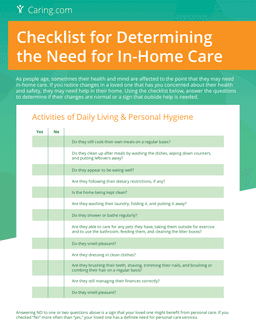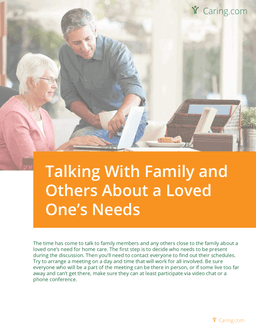
5.0
(1 reviews)
"Your support, care and guidance has been invaluable to our family. We now have a framework for making care decisions that we feel confident in. Thank you for being here and for caring...."
READ MORECaring.com offers a free service to help families find senior care and authentic reviews to help you in your decision. On average in Fontana, CA, residents and their loved ones rate In Home Care agencies across the 41 options below.
41 Results

5.0
(1 reviews)
"Your support, care and guidance has been invaluable to our family. We now have a framework for making care decisions that we feel confident in. Thank you for being here and for caring...."
READ MORECaring's Family Advisors are here to help you with questions about senior living and care options.
According to the Genworth Cost of Care Survey 2020, Fontana’s home care cost of $5,434 a month is $90 less expensive than the state average of $5,529 a month but is approximately $950 more expensive than the national average of $4,481. Oxnard is almost $100 a month less expensive at $5,339, while San Diego is approximately $280 a month more expensive at $5,716. Riverside is several hundred dollars less expensive at $5,053 a month.
Fontana
$5,434
California
$5,529
United States
$4,481
Oxnard
$5,339
San Diego
$5,716
Riverside
$5,053
Seniors in Fontana have a variety of available options. Home care is $5,434 a month. Home health care, which includes extra personal services and medical care, is $5,529 a month. Assisted living for seniors who can no longer care for themselves at home runs an average of $3,900 a month. Adult day care is the least expensive option at $1,907 a month, while a semiprivate room in a nursing facility is the most expensive option at $7,756 a month
Home Care
$5,543
Home Health Care
$5,529
Assisted Living Facility
$3,900
Adult Day Care
$1,907
Nursing Facility (Semiprivate Room)
$7,756
Note: Data for Fontana was unavailable, so data for the nearest city, Los Angeles Area, was used instead.
Given the high cost of in-home care, many people use one or more forms of financial assistance to cover the expenses. Below, we explain some of the most common sources of financial help for paying for in-home care. If none of these options are available to you, you can reach out to your Area Agency on Aging or Aging and Disability Resource Center to learn about local resources.
Long-Term Care Insurance: Long-Term Care Insurance covers expenses related to senior care, including in-home care. Depending on the policy type, beneficiaries may receive a cash payment to use towards long-term care or reimbursement for qualifying long-term care expenses. Note that there are limitations- typically a maximum benefit of $150 per day- and exact coverage terms vary depending on the exact policy, so always check the details.
Medicare: Medicare does not cover in-home care because it is classified as custodial, or non-medical, care. However, some Medicare Advantage and Medicare Supplement plans, which offer expanded benefits, may cover in-home custodial care.
Medicaid: Medicaid coverage of in-home care varies between different states because it is not a federally mandated benefit. Currently, all states cover some in-home care either through their standard Medicaid or a waiver program. The specific coverage rules are set individually by each state.
Veterans’ Benefits: The Aid and Attendance benefit is a monthly cash payment that beneficiaries can use to pay for senior care, including in-home care services. To qualify for A&A, Veterans must already receive the VA pension and meet several additional requirements, including needing assistance with the activities of daily living.Contact the Department of Veterans Affairs to learn more.
Reverse Mortgages: Home Equity Conversion Mortgages (HECMs) are federally insured loans that are available to homeowners age 62 and over. Reverse mortgages allow you to access a portion of your home’s equity in cash, tax free. Many seniors use reverse mortgages to finance their care expenses, including in-home care. Note that although there are no monthly payments due on reverse mortgage loans, borrowers do have to repay the loan once the last surviving homeowner passes away, moves, or sells the home.
Many seniors need to find low-cost resources that can help them save money when they’re aging in place. The resources listed below offer services and cost-saving measures that can help seniors live independently and safely in their homes.
| Resource | Contact | Service |
|---|---|---|
| Fontana Community Services - Nutrition | (909) 854 - 5151 | Fontana Community Services offers a delicious lunch five days a week at the Fontana Senior Center. Senior residents of Fontana aged 55 or older pay a reduced price for these meals. |
| Fontana Transportation Program | (909) 854-5175 | Another program of Fontana Community Services, the Transportation Program is a ride-sharing program for Fontana seniors aged 55 and older. The weekday service transports seniors within city limits to medical visits, the community center, hospitals, fitness facilities and shopping centers. |
| Fontana Community Senior Center | (909) 854-5151 | The Fontana Senior Center offers numerous resources for seniors 55 and older. It features a library with a seating area, a billiards room and card parlor, lounges and a snack bar. The center hosts regular excursions, special events, classes and clubs. |
| Home Care Services Bureau (HCSB) | (877) 424-5778 | The HCSB is the state of California agency that offers listings of organizations and individuals providing home care services. All the providers listed on the HCSB site receive background checks to reassure seniors and caregivers that the provider they hire is trustworthy. |
| In-Home Supportive Services (IHSS) | (916) 651-8848. | IHSS offers low-income seniors who want to age in place a waiver that can help pay for the cost of home care. A social worker visits applicants to determine if they qualify. If eligible, the social worker determines how many hours of help are needed each week and in what specific areas. Seniors who wish to apply for the program need to be American citizens, residents of California and eligible for Medi-Cal. |
Aging can be a difficult process, and loved ones may not always ask for help – oftentimes it’s up to their family to evaluate their need for help around the house. While no two situations are exactly alike, this checklist can help you and your loved ones determine when it’s time to start the search for a home care provider.


If you’ve determined that your loved one needs the assistance of a care provider in their home, it may be time for a difficult conversation. Handled correctly, however, this process can bring a family together and ensure that everyone’s concerns are addressed. Use this PDF as a starting point to help the conversation stay as positive and productive as possible.

